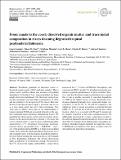| dc.contributor.author | Gandois, Laure | |
| dc.contributor.author | Hoyt, Alison May | |
| dc.contributor.author | Mounier, Stéphane | |
| dc.contributor.author | Le Roux, Gaël | |
| dc.contributor.author | Harvey, Charles F | |
| dc.contributor.author | Claustres, Adrien | |
| dc.contributor.author | Nuriman, Mohammed | |
| dc.contributor.author | Anshari, Gusti | |
| dc.date.accessioned | 2020-06-05T21:49:42Z | |
| dc.date.available | 2020-06-05T21:49:42Z | |
| dc.date.issued | 2020-04 | |
| dc.date.submitted | 2019-06 | |
| dc.identifier.issn | 1726-4189 | |
| dc.identifier.uri | https://hdl.handle.net/1721.1/125702 | |
| dc.description.abstract | Worldwide, peatlands are important sources of dissolved organic matter (DOM) and trace metals (TMs) to surface waters, and these fluxes may increase with peatland degradation. In Southeast Asia, tropical peatlands are being rapidly deforested and drained. The blackwater rivers draining these peatland areas have high concentrations of DOM and the potential to be hotspots for CO2 release. However, the fate of this fluvial carbon export is uncertain, and its role as a trace metal carrier has never been investigated. This work aims to address these gaps in our understanding of tropical peatland DOM and associated elements in the context of degraded tropical peatlands in Indonesian Borneo.We quantified dissolved organic carbon and trace metal concentrations in the dissolved and fine colloidal (< 0:22 μm) and coarse colloidal (0.22-2.7 μm) fractions and determined the characteristics (δ13C, absorbance, fluorescence: excitationemission matrix and parallel factor - PARAFAC - analysis) of the peatland-derived DOM as it drains from peatland canals, flows along the Ambawang River (blackwater river) and eventually mixes with the Kapuas Kecil River (whitewater river) before meeting the ocean near the city of Pontianak in West Kalimantan, Indonesia. We observe downstream shifts in indicators of in-stream processing. An increase in the δ13C of dissolved organic carbon (DOC), along with an increase in the C1=C2 ratio of PARAFAC fluorophores, and a decrease in SUVA (specific UV absorbance) along the continuum suggest the predominance of photo-oxidation. However, very low dissolved oxygen concentrations also suggest that oxygen is quickly consumed by microbial degradation of DOM in the shallow layers of water. Blackwater rivers draining degraded peatlands show significantly higher concentrations of Al, Fe, Pb, As, Ni and Cd compared to the whitewater river. A strong association is observed between DOM, Fe, As, Cd and Zn in the dissolved and fine colloid fraction, while Al is associated with Pb and Ni and present in a higher proportion in the coarse colloidal fraction. We additionally measured the isotopic composition of lead released from degraded tropical peatlands for the first time and show that Pb originates from anthropogenic atmospheric deposition. Degraded tropical peatlands are important sources of DOM and trace metals to rivers and a secondary source of atmospherically deposited contaminants. ©2020 BMJ Publishing Group. All rights reserved. | en_US |
| dc.description.sponsorship | US-Aid (PEER project “Assessing Degradation of Tropical PeatDomes and Dissolved Organic Carbon (DOC) Export | en_US |
| dc.description.sponsorship | Singapore–MIT Alliance for Research and Technology (Center for Environmental Sensing and Modeling Interdisciplinary Re-search Program) | en_US |
| dc.description.sponsorship | US National Science Foundation (grant no. 1114155) | en_US |
| dc.description.sponsorship | US National Science Foundation (grant no. 1114161) | en_US |
| dc.language.iso | en | |
| dc.publisher | Copernicus GmbH | en_US |
| dc.relation.isversionof | https://dx.doi.org/10.5194/bg-17-1897-2020 | en_US |
| dc.rights | Creative Commons Attribution 4.0 International license | en_US |
| dc.rights.uri | https://creativecommons.org/licenses/by/4.0/ | en_US |
| dc.source | Copernicus Publications | en_US |
| dc.title | From canals to the coast: Dissolved organic matter and trace metal composition in rivers draining degraded tropical peatlands in Indonesia | en_US |
| dc.type | Article | en_US |
| dc.identifier.citation | Gandois, Laure et al., "From canals to the coast: dissolved organic matter and trace metal composition in rivers draining degraded tropical peatlands in Indonesia." Biogeosciences 17, 7 (April 2020): 1897–1909 doi. 10.5194/bg-17-1897-2020 ©2020 Authors | en_US |
| dc.contributor.department | Massachusetts Institute of Technology. Department of Civil and Environmental Engineering | en_US |
| dc.contributor.department | Singapore-MIT Alliance in Research and Technology (SMART) | en_US |
| dc.relation.journal | Biogeosciences | en_US |
| dc.eprint.version | Final published version | en_US |
| dc.type.uri | http://purl.org/eprint/type/JournalArticle | en_US |
| eprint.status | http://purl.org/eprint/status/PeerReviewed | en_US |
| dc.date.updated | 2020-05-27T14:45:30Z | |
| dspace.date.submission | 2020-05-27T14:45:33Z | |
| mit.journal.volume | 17 | en_US |
| mit.journal.issue | 7 | en_US |
| mit.license | PUBLISHER_CC | |
| mit.metadata.status | Complete | |
